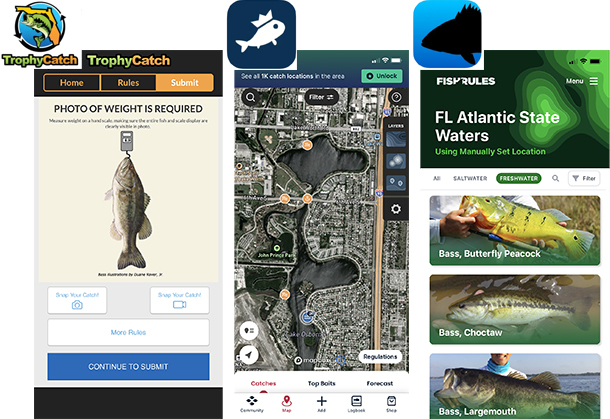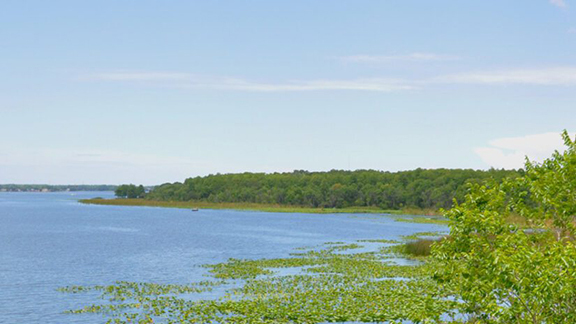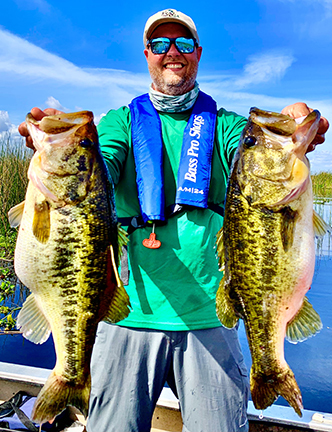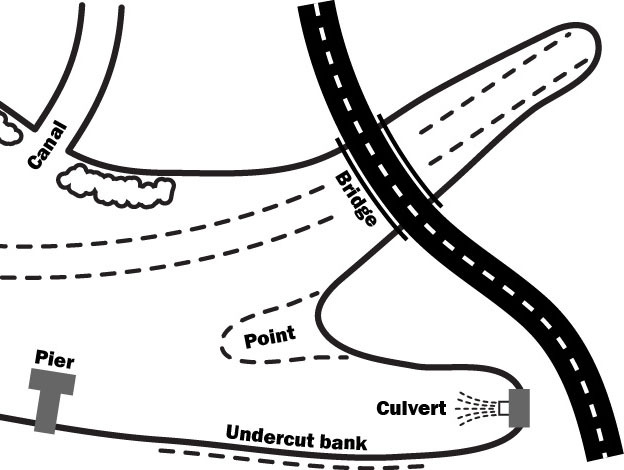|
Chad Dorland moves into the lead with the biggest Hall of Fame bass of Season 11 yet. This 14 lbs. 1 oz. monster came from Orange Lake, which has been posting some huge catches this year.
As TrophyCatch Season 11, the Season of Research, continues here are some more "bass facts" that your submissions have revealed!
- An amazing 123,304 pounds of bass have been caught, documented, and RELEASED through TrophyCatch since the program began in 2012.
- 82% of TrophyCatch approvals are from Florida residents, compared to 18% for nonresidents.
- The farthest distance any TrophyCatch participant has travelled to fish Florida is all the way from Russia!
- March is the month that averages the most TrophyCatch approvals annually, which corresponds with Florida's yearly bass spawning peak.
Currently at the end of June, TrophyCatch submission numbers stand at:
- 11,391 Lunker Club (8-9.9 lbs.)
- 2,853 Trophy Club (10-12.9 lbs.)
- 138 Hall of Fame (13+ lbs.)+
- 14,382 TOTAL approved submissions to date
If you are already a TrophyCatch participant, we thank you for your contribution to the program. If you have not participated yet, even if you never submit a bass you can show your support for bass conservation by registering today at TrophyCatch.com. You can also stay up to date by signing up for email updates here (check the "TrophyCatch" box).
In the Battle of the Lakes, Fellsmere continues to dominate the scorecard, but Orange Lake is making it a fight with multiple Hall of Fame fish approved including Chad Dorland's monster and current season leader shown above. Keep casting for your favorite as the battle continues to unfold — victory for either side is far from certain! For Battle of the Lakes details see:
https://www.trophycatchflorida.com/rules.aspx#battle
Size: The state record is 6.96 pounds, although most fish will average between 1-2 pounds. The Big Catch minimum qualifying sizes are 3.00 pounds or 22 inches for adults, and 2.25 lbs or 17 inches for youth (see BigCatchFlorida.com).
Appearance: The toothy mouth and elongated shape of the chain pickerel are diagnostic, as is the unique, chainlike patterning along the body from which this species draws its name. The redfin pickerel (as the name states) has red fins, is smaller (seldom exceeding a pound), and lacks the chainlike markings. A pickerel’s broad snout easily distinguishes it from a gar’s narrow mouth.
Range & Habitat: Chain pickerel are uncommon to common throughout Florida's lakes and rivers, and can also be found in south Florida's extensive canals. They are seldom far from vegetation and prefer quieter pools of streams or rivers.
Sporting Quality: More sought-after in northern states, chain pickerel are generally caught unintentionally in Florida—usually by bass anglers. This is due to the pickerel’s love of minnows and minnow-imitating lures. Saltwater anglers will note a body design that mimics a barracuda’s, and this fish is indeed built for speed. Strikes are usually very fast and aggressive. Once hooked, the chain pickerel is known for its fast runs and jumping ability. Some bass anglers lament the damage a pickerel’s teeth can do to a lure or bait, but others welcome surprise strikes from this torpedo-shaped aerialist and consider a scuffed lure a small price to pay for the adventure. Due to this toothy mouth, care should be taken when landing. While pickerel are certainly edible, many small bones make it difficult to separate the meat and most enthusiasts consider the pickerel to be much more a sport fish than a table fish.
Fish illustration by Duane Raver, Jr.
If all you're doing is making calls and watching cat videos, you're not tapping the fishing potential of your smartphone! This self portrait was taken with a smartphone using a mini tripod and a self-timer app.
You use it to text, play games, shop, watch cat videos, and keep up on your friends' activities. You might even use it to make calls! But do you use your smartphone to catch more fish? If not, you are missing out!
Loosely defined, a smartphone is a cell phone that has added capabilities, essentially the marriage of a cell phone to a camera, GPS, and PDA (personal digital assistant). Currently, the most popular smartphone platforms are iPhone and Google Android in the US (though Android is dominant worldwide). Features and capabilities vary widely, as do the various cell phone service providers and the hardware and service plans they offer. Be aware that in addition to basic cell phone service, you may need to sign up for a data plan if you want to take full advantage of all of your smartphone’s capabilities.
 Helpful fishing apps include (left to right) TrophyCatch, Fishbrain, and Fish Rules.
So what kinds of things can smartphones do? Understand that they are essentially miniature computers, and just like computers they can run a wide variety of programs. These programs are called apps (short for applications). Certain apps may only be available for certain platforms, but many of the most popular apps have very wide compatibility. The good news is that apps are cheap compared to computer programs, usually only costing a few dollars apiece or a nominal monthly fee.
For starters, the free TrophyCatch app streamlines submitting your catch on your phone, straight from your boat out on the lake if you don't want to wait until you get home. Fishbrain provides a way to log your catches, share them with other anglers (and see their catches), and includes current Florida fishing regulations organized by fish species. Fish Rules does what its name promises, providing current fishing regulations as well as fish identification organized by fish species and based on your location. Note that for any app that uses your location (for fishing regulations for example), you will need to enable location services, i.e. give the app permission to know where you are.

And that's just the beginning! There are a number of other smartphone features we’ll be discussing, but one of the most helpful is the built-in GPS with mapping. Whether you’re trying to find the boat ramp, a tackle shop, or your secret fishin’ spot, you almost always have mapping capabilities with you as long as you have your smartphone and a good signal.
Here’s a personal example: An angling buddy and I were fishing a series of short canals along a major urban road in southeast Florida. We also planned to hit a nearby lake tucked away behind some buildings, which we soon realized wasn’t visible from the canals. When we began to suspect we might have overshot the lake, I whipped out my phone and discovered that, sure enough, it was behind the buildings along the last stretch of canal we’d just fished. I figure my phone saved us at least ten minutes’ scouting and backtracking time—time we would much rather spend fishing.
Depending on where you fish, a smartphone can be extremely helpful in navigating your way around the many smaller lakes and canals dotting parts of the Sunshine State. Most mapping systems feature several views or "layers": standard (roads), satellite (topographic, similar to satellite photos), and hybrid (both, with roads as well as natural features shown). For navigation consider switching to standard when you're driving, and then to satellite or hybrid when actually on the water. You can even buy car brackets that will let you mount your phone on the dash or window of your car or boat, just like a regular car GPS. Smartphones also allow you to take screenshots, a handy feature to record photos showing important map locations on the waters you fish.
|

One of the handiest gizmos included in most smartphones is the camera. You now have a pretty decent point-and-shoot camera with you wherever you go, without the need to remember to throw one in your tackle pack when you head out the door. In fact, phone cameras have gotten so advanced that some professional journalists simply use their smartphone camera for general photography. I’ve gotten some great pictures in situations I never would have brought a camera to and am always ready to snap a shot of “the big one,” no matter where or when it bites. Some phones have excellent cameras with outstanding exposure control built in, suitable for magazine quality picture-taking.
There are also various methods and accessories for taking "selfies" (self portraits) of you and your fish. On a boat, you can mount a smartphone bracket in a variety of locations. If you are on foot, mini tripods and "selfie sticks" with built in tripod feet allow you to quickly set up your camera for some photos. Install a photo app with a self-timer that lets you set how many photos to take in a sequence, and you will be all set to hit the button and pose with your catch. Personally, I've found a 10-photo sequence gives me plenty of time to start the sequence and then strike a couple different poses with my catch for a memorable shot. Of course, you can always go old school and just hold your smartphone at arm's length, though a more posed shot looks much better.
While if you like to tweak your photos, you may do most of your photo editing on your computer, there’s a dizzying array of apps that will let you edit, modify, or add captions or other graphics to photos right on your phone before messaging them off to jealous fishing buddies, right from boat or shore. Brightening shadows and adjusting the lighting and contrast can make a fair photo look amazing. It’s great not having to wait until after you get home and park the boat to share your catch with a friend or family member.
“E-tournaments” are using smartphone technology so that an angler can photograph their fish right on the water, release it almost immediately, and then multimedia message the photos to the tournament coordinator for entry. One of the really nice features of phones with built in GPS is coordinate tagging of the photos you take. Depending on your phone features (or phone or computer software), you can open a picture of a bass and then see where you caught it on a map as well as the date—pretty handy for keeping track of the where and when of all those fishing trips.
These are just a few of the ways that smartphones can help make fishing more productive and enjoyable. Stay tuned for Part 2 in the next issue!
Map image used with permission by Google Earth™.
|
 |
Size: 2,534 acres
Location: Pinellas County
Description: Lake Tarpon is a 2,534-acre Fish Management Area near Tarpon Springs in Pinellas County. As part of FWC’s Long Term Monitoring efforts, the lake is sampled on a yearly basis, with largemouth bass being sampled every Spring and a comprehensive all-species community sample every Fall. Despite being in the highly developed Greater Tampa Bay Area, Lake Tarpon experiences relatively low fishing pressure overall and routinely produces quality populations of largemouth bass, bluegill and redear sunfish during annual sampling events.
Historically, Lake Tarpon has had excellent water quality and abundant populations of fish and wildlife. However, in recent years Lake Tarpon and its watershed have been substantially impacted by issues such as nonnative aquatic vegetation and continued development around the lake. The lake historically had no outlet, other than a tidally influenced sinkhole on the northwest shoreline. In the late 1960s, the sinkhole was disconnected from the lake by construction of a berm and an outlet canal was created on the southern end of the lake. These changes largely reduced the number of flooding events around the lake; however, this altered hydrology may have contributed to the expansion of water primrose and cattail throughout the shoreline area, which poses a threat to native aquatic vegetation.

As the largest lake in Pinellas County, Lake Tarpon is vital to recreational fishing, kayaking, bird watching, boating and wildlife viewing opportunities. Many housing developments surround the lake, serving both permanent and seasonal residents. The lake is a Southwest Florida Water Management District Surface Water Improvement and Management (SWIM) program priority water body. The SWIM Program focuses on water quality and habitat restoration projects in conjunction with the help of state agencies, local governments, and other organizations to meet its goal of restoring and protecting damaged and at-risk water bodies. Given this significance and the risks posed by expanding nuisance species, FWC biologists and staff at Pinellas County Environmental Management proposed a muti-phase management plan focusing on the removal of non-native and nuisance aquatic vegetation, followed by revegetation efforts to increase biodiversity of native aquatic vegetation. When complete, these efforts will bolster the already excellent recreational opportunities found at Lake Tarpon with enhanced habitat and improved water quality.
Lake Tarpon has a sand and clay bottom with an expansive and diverse vegetative ring around it that, thanks to ongoing management work, offers great angling opportunities all year long. Largemouth bass anglers can find success working a Texas-rigged worm or slowly retrieving a spinnerbait along the edge of the Littoral zone just before it drops off into deeper water. Bait anglers can find success drifting live shiners near patches of grass for finicky largemouth bass unwilling to bite a lure. Panfish can often be taken using crickets or worms suspended below a slip bobber along patches of grass. Populations of black crappie (specks) can commonly be found on deep-water structures and can be taken using live shiners or small jigs, with the best results coming from small red and chartreuse tube jigs. For a unique opportunity in freshwater, anglers can find populations of common snook congregating on the shelf along the canal at the south end of the lake. These fish will pose challenging to freshwater anglers, putting up an intense fight. Snook are often caught using swim baits, crank baits, or larger live baits like shad or shiners.
|
 |
Living "on the edge" is a necessity for fish, and knowing this will put more of them on the line for anglers.
“Living on the edge” is something you might say about someone who likes taking chances or enjoys living dangerously. And wild animals, including fish, live dangerously almost every minute of their lives. But many animals—especially fish—live “on the edge” in another way, too.
Have you had the experience of consistently catching fish from the same "hotspot" location in a lake you know well, trip after trip? If so, chances are good that you've located an edge of some kind. Whether it’s a submerged roadbed, sudden drop-off, weed edge, or underwater fenceline, fish love to hang out around edges. There are several good reasons for this. First, an edge is often a meeting of two habitat types, such as open lake connected to a shallow marsh. Such a habitat edge is called an ecotone, and for a bass that can mean twice as much chance of finding forage wandering from one habitat type or the other. An edge like a shoreline bulrush stand can provide cover, too, for both an ambush predator like a bass and a forage species like a bluegill. A drop-off can provide concealing shade during part of the day. A submerged roadbed, fenceline or natural channel might be used as a travel corridor. Other boundaries the savvy angler will look for can include the shoreline itself, spikerush stands or lily pad fields, hydrilla mats, docks and piers, bridge pilings, underwater humps, canal intersections, water control structures and culverts, undercut banks or even a single fallen tree or large rock.
Edges aren’t always created by physical structure. The edge of a current flow or the border between muddy water and clear can also draw fish. The calmer edges of a culvert outflow are also a great place to toss your lure. Fish under a bridge will often stay within its shadow, and snook at night love to hang out at the very perimeter of a light shining on the water. All of these different types of borders will attract and hold fish, for a variety of reasons. So if you feel like your life has been a little boring lately, think like a fish and try fishing “on the edge”!
To contact the Florida Freshwater Angler, email John Cimbaro. Fish illustrations by Duane Raver, Jr. and Diane Rome Peebles.
|